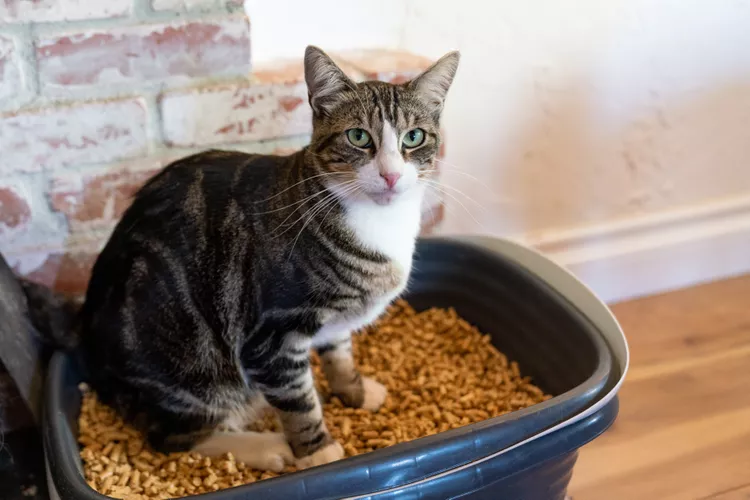- 01 of 09
Clay Litter
Clay cat litter is the most popular litter choice for cat owners, probably in part because it is also one of the most well-established and easy to come by.
Low dust and dust-free options are available along with scented or unscented varieties. Some of these litters are made up of large pieces of clay and others are finer clay particles, but they all absorb urine and turn into a softer, wet cement-like texture when they do. There are even clay litters that contain attractants to entice a difficult cat to use the litter box more.
There are two main types of clay cat litter: clumping and non-clumping. Clumping cat litter is often preferred by many cat owners who like to scoop out the litter box regularly, but others like the lower cost of non-clumping litter and will dump the entire litter box contents when necessary.
Some disadvantages of clay litter include the fact that it is not environmentally friendly, the amount of dust that is present, the heavy weight of the litter, and how much the litter tracks through the house. However, the price point and availability of most clay litters still make it a popular choice for cat owners.
- 02 of 09
Silica Gel Litter
Growing in popularity, silica gel cat litter is made by several different companies. Most companies advertise that silica gel litter is not as dusty as clay, traps urine without having to scoop it out of the litter, lasts longer than the same amount of clay litter, offers excellent odor control, and is sometimes even preferred by cats over clay litter.
Silica gel litter is usually more expensive than a clay litter bag of the same weight, but since it lasts longer, some pet owners do not see a significant price difference. Some types of silica gel litters, like Pretty Litter, even have color-changing indicators in them to help monitor a cat's urinary system health.
- 03 of 09
Pine Litter
Pine litter is popular because of its natural ability to fight off odors. Being made from pine trees, it is also lightweight, has low dust, is absorbent, and is softer than clay litter.
Some cat owners like a more environmentally friendly option, and this one provides some of the best odor control. There are both clumping and non-clumping pine options available. Non-clumping pine litter typically comes in a cylindrical pelleted form while the clumping form is a ground-up pine litter that looks more like sawdust.
- 04 of 09
Wheat Litter
Similar to pine litter, wheat litter is also an environmentally friendly alternative to clay litter, but it is made from processed wheat. If you're looking for an odor-controlling litter option, this one is a great pick because it also clumps and is flushable. There are not usually any added dyes or perfumes to this ground-up, granular product. When a cat urinates on wheat litter, it turns into a sawdust-like material and can be scooped out of the box.
Continue to 5 of 9 below - 05 of 09
Grass Litter
Less commonly available than most of the other types of cat litter, grass litter is another natural alternative to traditional clay cat litter. It looks similar to pine or corn litter and is a dried, biodegradable, grass seed litter. It clumps so that waste can be scooped out and typically does not contain dyes or added chemicals that some cat owners try to avoid. It is also naturally low-dust and softer and lighter than clay litter.
- 06 of 09
Corn Litter
Another natural cat litter option is corn litter. It may come in a scented variety but it is still a biodegradable option. It clumps and absorbs urine, is lightweight when compared to clay litter, and is composed of dried corn kernels. There are even some corn litter options that contain cat attractants.
Some concerns with corn litter include mold growth, specifically aflatoxins, since corn can easily produce this type of toxin, and decreased clumping capabilities. Aflatoxins can be deadly to pets, so while some companies guarantee their litters are safe and most owners have never had an issue with corn litter, some pet owners choose other options. The lower level of clumping of corn litter has also been discussed among cat owners, but most still consider it functional.
- 07 of 09
Walnut Shell Litter
Natural cat litter options have expanded to include walnut shell litters. These ground-up walnut shells have high absorbency when compared to clay litter, work well for odor control, and clump too. Low dust makes this type of natural cat litter extra appealing but some brands seem to give off red or brown dust depending on how much a cat likes to kick it around.
Granular in appearance, walnut shell cat litter is low-tracking and biodegradable. Some cat owners even feel this type of litter lasts longer than the others they've tried in multiple cat households.
- 08 of 09
Paper Litter
Popular for cats with injuries to their paws, paper litter can be processed, recycled paper material, or simply shredded newspaper. These litters have little dust or concern for irritating wounds, have no fragrances, are softer than clay litters, and are absorbent. Unfortunately, these litters do not clump or control odors very well, so they are often only used short-term.
Continue to 9 of 9 below - 09 of 09
Tofu Litter
This eco-friendly litter alternative is made from soybean pulp formed into small pellets. It's non-toxic, helps mask odors, produces little or no dust, and won't stick to paws as much as other options. Since the pellets clump together with urine but dissolve in water, you may be able to flush them in small quantities (but check your local ordinances) or toss them into a compost bin.

:strip_icc():format(webp)/The_Best_Cat_Litter_Subscriptions_of_2021_edit-7044b6ee449646deadd5c57680e2b2db.jpg)



















